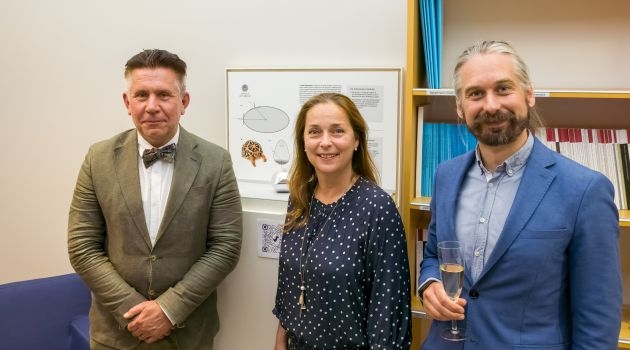“The mathematics in a Gömböc is impressive”
Hello Georgios Dimitroglou Rizell, head of the Department of Mathematics, who was recently presented with a Gömböc by the Hungarian Ambassador at a ceremony held in the Ångström Laboratory.
in aluminium and is 90 millimetres in height.
Photo: Department of Mathematics, Uppsala Univer-
sity
So, what is a Gömböc?
“It’s a three-dimensional object with only two points of equilibrium when resting on a flat surface. As one of these equilibria is unstable, the object will always turn around until it comes to rest on the other point. Such objects are easy enough to construct from inhomogeneous material, by placing extra weight somewhere in the object, for example, or an object that is not convex but has indentations or holes. However, if you want uniform density and a convex object, it requires a complicated shape, and the Gömböc realises such a shape.”
How did this object come to be donated to Uppsala University?
“The background is a European programme founded by the Hungarian Otto Albrecht, which donates individual Gömböc models to selected universities and institutions around the world. The initiative was taken by Albrecht and mathematician Gábor Domokos, who invented the shape together with Péter Várkonyi, another Hungarian mathematician.
Where is Gömböc#1477 now?
“It is in a display case at the Department of Mathematics in Building 6, where everyone is welcome to take a look at it. We have plans to construct a plate in the case that can be controlled from the outside, as it would be great to give visitors the chance to see it rolling around. We shall see if we can develop the exhibition in some way, perhaps adding an ellipsoid to see how this behaves, as it has more equilibrium points than a Gömböc. It should be possible to use it in some form of teaching; it’s an interesting object to demonstrate. The mathematics is impressive and there are many tricky problems involved in attempting to understand its properties.”
In what way is a Gömböc interesting to you as a mathematician?
“Personally, the theoretical construction may be the most interesting aspect. There is still an unresolved problem regarding the number of equilibria in higher dimensions. There one can ask a kind of converse question: how many such points can we have if we are allowed to vary the density of the object? Is there always some mass density that creates a great many equilibria? This is a reasonable, if difficult, question, so there are many related areas for continued research.”
Anneli Björkman

